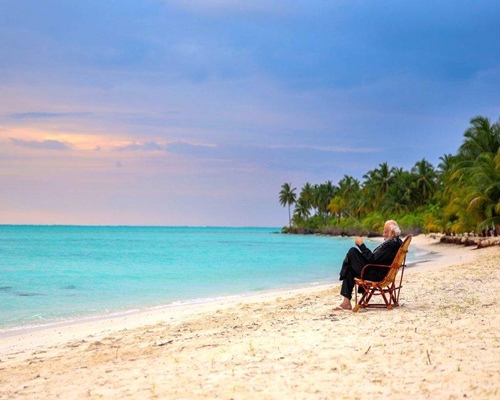
It wasn’t until 1973 that a group of small coral islands, earlier known as Laccadive, Minicoy,
and Amindive, were unified to be collectively recognized as Lakshadweep. Before this, the
islands were left open to be widely explored by many who brought their own intentions to
either capture or exploit, and this included the Arabs, the Cholas, the British, the
Portuguese, and speculatively, even Vasco Da Gama.
The arrival of the Portuguese remains one of the most significant events in the islands’
history because it marked the beginning of the years of pillaging that were to follow. They
were specifically concerned with the production of coir (coconut fibre) which was used in
ships and built a fort to control its trade along with other commodities. In retaliation, the
locals reportedly put an end to the Portuguese invasion by using poison. The inhabitants of
these islands can, thus, be understood to have always been protective of their land and
culture which continues to reflect even today. Lakshadweep is listed among the most
restrictive places in India where out of the 36 islands, only a selected few are open to
tourists while requiring a permit to be issued for visit, a rule which extends even to Indian
citizens.
According to the guidelines under the Restriction on Entry and Residence Rule 1967, all
persons apart from Lakshadweep residents require permission from the authorities to
enter the area. The reason behind this relates primarily to the Scheduled Tribes who form
95 per cent of the populace in the islands. By restricting mass tourism, the officials attempt
to protect the community’s cultural heritage from being disturbed.
Having considered this context, we may begin to notice how the sudden spotlight on this
region might pose a challenge to the localities, in contrast to the benefits that have been
surfacing all over social media. Following the visit of our Prime Minister, there has been a
spectacle of events that led to Indian tourists turning towards Lakshadweep for their next
travel destination with the claim to promote national tourism. But that’s not all, as you
might be aware, over the past few weeks, #boycottmaldives has rapidly gained momentum
in X, along with the popular faces in Bollywood joining in with their selective activism. It
does make one wonder about the accumulated interest towards Lakshadweep and whether
the intention behind the whole affair relies more on appreciating our country, or if it is only
an attempt to shun the Maldivians.
Maldives' economy relies heavily on tourism itself where India has been one of the top
contributors of the same and considering the recent developments, their business is sure to
take a hit. However, that doesn’t necessarily make it any better for the Lakshadweep
residents as well.
Although the islands can flaunt their rich biodiversity with their coral reefs and marine life,
they suffer from a very fragile ecosystem. The prescribed restrictions are also an attempt to
let Lakshadweep’s natural beauty remain untouched. Furthermore, its remote location and
limited infrastructure makes it difficult for the islands to be able to support large-scale
tourism. These islands have been built in a way that prioritises its environment over
growth in tourism, and perhaps rightly so.
Mass tourism has, more often than not, left its welcoming destinations in a disgraceful
state. From an exhaustion of the scarce water resources in Leh to the rapid generation of
waste in the beaches of Goa, we can observe the footprints left by tourists all around us.
Moreover, the glorification of these locations only for their ‘exotic beauty’ not only erases
their entire history, but also reduces them to mere souvenirs to be shared in our social
media profiles.
A study by the Kerala State Council for Science, Technology, and Environment (KSCSTE),
states that Lakshadweep’s coral reefs already face threats from pollution, dredging of
navigational channels, coral mining, and destructive practices like blast fishing. The sea-
level rise triggered by global warming has also been heavily impacting the archipelago’s
beaches and sand dunes. It’s also crucial to note that the survival of these islands primarily
depends on the marine life and resources spread in over 400,000 square kilometres around
it.
India has certainly made efforts to proceed towards sustainable tourism with numerous
policies by the government and the Ministry of Tourism such as National Strategy for
Sustainable Tourism, National Strategy for Ecotourism, Draft National Tourism Policy
2022, Swadesh Darshan Scheme 2.0, and more. These steps mainly aim to develop an eco-
friendly mode of tourism along with an increased protection towards the culture of the
concerned lands, while making sure that the local economies receive adequate benefits..
However, the effectiveness of such schemes relies more on the awareness of the tourists
and the effort they are willing to put to make sure that their beloved destinations remain
available for future generations as well. A few personal decisions we can make as travellers
would be to minimise flying, pack reusable products, and support local businesses. It’s also
advisable to consume the local cuisine by simultaneously avoiding big food chains and
restaurants.
When we look at the current controversy, our Prime Minister’s walk on the beach has
evidently led to the unfolding of various political and economic developments. With
worldwide Google searches for ‘Lakshadweep’ reaching an all time high and domestic
airlines including additional flights to the islands, there is an urgent demand for our
attention to go towards sustainability in tourism; because since the entire nation has begun
to flock towards the archipelago, we should be aware that these islands have not been built
to carry the weight of our nationalistic sentiments.